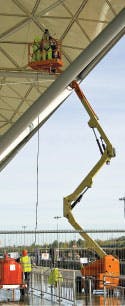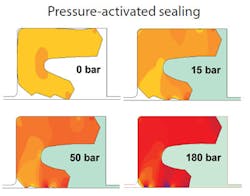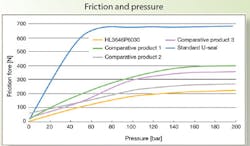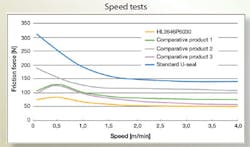By Walter Igers
Thomas Papatheodorou
Parker Hannifin GmbH
Operators of fluid-power systems increasingly demand friction-optimized piston and rod seals for hydraulic cylinders. Excessive friction not only wastes energy, it can also accelerate wear and lead to premature seal failure. But too little friction and a seal leaks. Getting the balance just right across varying pressures and operating conditions has been an ongoing challenge for seal manufacturers.
Parker Hannifin’s Seal Group has developed a product that meets this goal. The company’s new Ultrathan HL rod seal features a series of cascading, pressure-activated sealing lips that, according to Parker officials, reduce static and dynamic friction in hydraulic cylinders.
Compared with conventional U-rings, the HL single-acting rod seals reportedly reduce friction-related losses by 30 to 70%, depending on load, without compromising sealing capability. This increases hydraulic-system efficiency and can lead to significant energy savings.
Stepped pressure activation
Various parameters influence friction in hydraulic seals. The size of the contact area between the seal and respective sliding surface is one key factor. In essence, the larger the contact area, the higher the static and dynamic friction.
Also, hydraulic-system pressure dictates the amount of friction required to prevent fluid from leaking past the seal. For example, friction at lower system pressures, or in differential cylinders with small pressure differences, is significantly more critical than in cylinders operating at higher pressures. With conventional U-seals, a large portion of the dynamic sealing area typically contacts the piston-rod surface even at low system pressures, which increases friction. The HL takes a different approach.
The HL seal profile features three individual sealing lips that consecutively contact the mating surface as pressure rises. In low pressure or pressureless conditions only one lip contacts the rod. The resulting small contact area produces significantly less friction, compared with standard U-cups. And less friction means the seal generates less heat, permitting higher travel speeds. In addition, because only the primary sealing lip engages at low pressures, the HL minimizes breakaway friction typical after prolonged down time.
As system pressure rises, the seal’s cross section deforms slightly and additional sealing lips are activated. Thus, sealing capabilities increase with pressure and the number of sealing edges in contact with the rod.
Multiple sealing lips also reduce the amount of oil on the rod surface that seeps past the seal as the cylinder strokes, further reducing leakage. Although dynamic friction slightly increases as more lips engage and the contact area enlarges, overall, it remains at a low level. In addition, the design virtually eliminates the risk of stick-slip at slow travel speeds.
The result is low friction and tight sealing at all pressures.
New materials
Performance of the new geometry also depends on the seal material, a newly developed polyurethane called P6030.The material is specifically designed for low-friction, fluid-power applications. It handles a wide range of temperatures and has good mechanical strength, high extrusion and wear resistance, and low compression set. It is compatible with mineral-oil and PAO-based hydraulic fluids, and materials for bio fluids (HEES and HETG) are available as well.
Endurance tests performed according to ISO 7986 gauged the long-term performance of HL seals made of P6030. Seals were installed in cylinders with 36-mm diameter, hard-chrome-plated rods and a 250-mm stroke. The seals were subject to pressures from 0 to 200 bar, temperatures of 65°C, and rod speeds of 0.15 m/sec for 500 km (1 million cycles) to determine friction and leakage behavior as well as deformation and wear.
Results showed no significant extrusion, no abrasion on the sealing edge and surface, no changes in sealing edge contours, low plastic deformation of the seal profile, and low preloading loss (less than 30%).
Wide application range
The HL rod seal can be used as both a single seal with a wiper and in a sealing system — as a secondary seal behind a primary or buffer seal. The seals are designed for maximum operating pressures of 250 bar (3675 psi) and operating temperatures between –35° and 110°C.
The HL Ultrathan rod seal is suitable for a wide range of hydraulic applications requiring minimal friction, such as lifting platforms, lift trucks, and loading gates. Test and automation cylinders, cylinders for ag equipment, and gas springs are other typical applications.
Walter Igers is Development Engineer and Thomas Papatheodorou is Manager of Technical Services at Parker Hannifin GmbH, Packing Div., Europe, Bietigheim-Bissingen, Germany. For more information, contact the Parker Hannifin Seal Group, Cleveland, or visit www.parker.com.
Friction-force tests
Parker engineers performed a series of tests to compare the behavior of the HL design with that of other commonly used seals. Friction-force tests were conducted at varying pressures, temperatures, and speeds on both new seals and seals previously subjected to prolonged endurance tests.
Results revealed that the HL seal geometry clearly reduces friction, compared with conventional U-seals and other versions of friction-modified seals. This applies across a wide pressure range from low levels up to 200 bar.
At low speeds the new design exhibits significant friction benefits. Particularly with regard to undesirable stick-slip, improvements were seen at higher temperatures and speeds across the entire pressure range.
The comparison demonstrates that friction losses encountered with the HL rod seal, depending on the load, can be reduced by 30 to 70% compared with a standard U-seal. This results in considerable energy savings, benefiting operating budgets and the environment.





